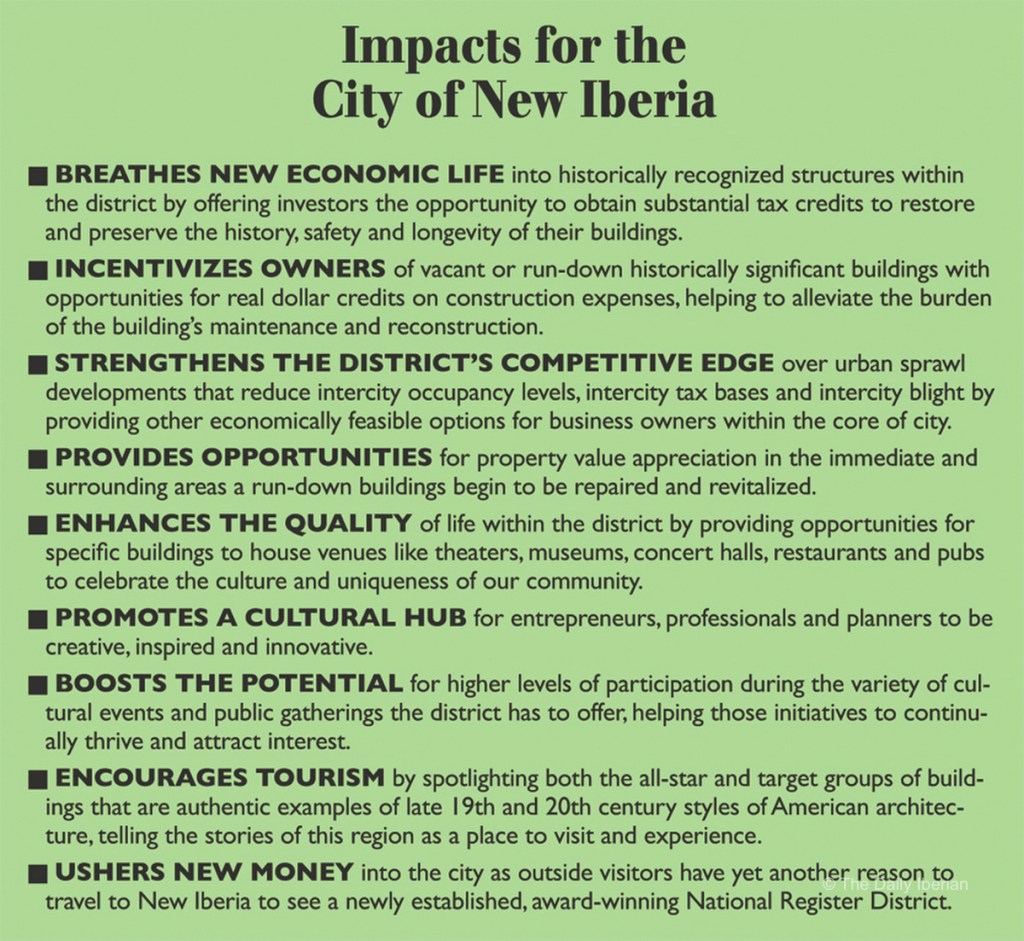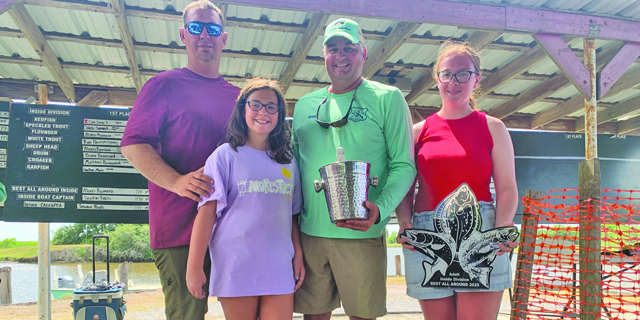Snapshots of the future
Published 5:00 am Sunday, October 22, 2017

- Snapshots of the future
Photography helped preserve the past — now being used for growth
Trending
The Main Street Program, a national organization sponsored by The National Trust, was a pilot program in three states initiated in small towns because downtowns were dying — in part because of the interstate system taking traffic away from the vitality of downtowns — the communities’ heart. Malls had become very popular and traffic was no longer going through the main streets but were rather diverted around the cities.
The National Trust started the Main Street Program for downtown revitalization. Louisiana was one of the pilot states with New Iberia being accepted as part of the program in 1993. The criteria covered four areas, design, promotion, organization and economic restructuring. When the historic district was created, The National Register District was residential, mostly on East Main Street, and then came the downtown district — commercial.
“To confuse matters more, we’re creating a new district which is a downtown National Registry District,” Braud said. “The commercial district starts at Weeks Street, Bayou Teche is the northern most boundary to Hopkins Street. The new district shortens the commercial area. When I talk about the Main Street Program, it’s the downtown revitalization district. It’s certainly not the only reason why our downtown has revitalized since the 1970s, 80s and 90s, when I came to work for the city.”
Braud credits the business people who stepped up to the plate to purchase historic buildings, went to the expense of preserving those buildings, bringing them back to what they were and taking an active role in bringing them back commercially with businesses inside. The main focus for future development is to bring residential to the second floors, commercial to the first floors.
“Go back to the 1800s and that’s what they did,” Braud said. “They lived over their work spaces. Most of our businesses were not occupied at all on the second floors, they’re vacant, used for storage. That’s wasted space. The idea finally hit home. Chris Jordan was the first with the Gouguenheim. We talked way back then about his idea to bring the building back as shown in the Carroll Martin photograph.”
Taking Initiative is Complex
Trending
Early in the department of planning and zoning, there were city codes prohibiting some renovations that were part of the original restoration planning — an ordinance prohibited balconies. When that was discovered, Braud and city planners got to work evaluating and changing the restrictions to allow the process of changing downtown to begin. A committee was formed with architects, construction engineers and others who found a way to bring the codes up to the development now in place. Restorations were ready to begin. The designation as a Main Street Program gave weight on the state level.
“The state was offering a façade grant that allowed for $10,000 for outside work as a preservation grant. To receive a grant you have to be in the process of trying to restore it and as always, meet the criteria of the grant. Jordan received a grant to help with the Gougenheim and shortly thereafter the Bojangles building across the street.”
Restoration of historic buildings are not just putting new faces on the building or fixing the mortar, it requires an understanding of restoration using proper techniques and materials — something Mayor Freddie DeCourt learned long before becoming mayor. His 14 historic properties coupled with the ones architect Paul Allain has been commissioned to work on, make the possibility of revitalization an exciting prospect for current and potential property owners.
What Makes New Iberia Unusual?
Braud is quick to give credit where it is due and recognize the effort is a community achievement.
“I hear all over the state from other communities how they can’t believe our different organizations work so well together,” Braud said. “Like our Main Street Program partnered with the Downtown Business Association because we were duplicating our services. DBA is a membership program, Main Street provides services to anybody within the district, but we all provide services to downtown businesses.”
The Downtown Business Association and Main Street Program helps sponsor most of the events mounted in the Queen City like Beneath the Balconies or the Christmas Parade and the twice-weekly farmers market which varies depending on the produce available. The Greater Iberia Chamber of Commerce is another vital part of the success, Braud explained.
“And of course, Fran (Thibodeaux, Iberia Parish Convention and Visitors Bureau) supports everything,” Braud said. “I hear in other communities, ‘how did you get the chamber to participate, or ‘how did you get the tourist director to give you money for signage?’ It is just what we do, because it benefits everybody. They say it just doesn’t happen (in their communities).”
When Will the Designation Occur?
The national park service is still reviewing the proposal, the same material that will be presented by Braud, Paul Allain and Milton “Bo” Belanger at 5:30 p.m. Monday, Oct. 23 at The Sliman Theater. Presented by the Iberia Preservation Alliance, a coalition of the Bayou Teche Museum, Iberia Cultural Resources Association and the Shadows-on-the-Teche, the talk is presented to the community so they can share in the excitement and anticipation of this new growth potential. Although still in review nationally, having been unanimously approved at the state level gives planners great hope for the future.
Almost a Ghost Town
Braud remembers when New Iberia went through a bleak period in the 1980s but held on because of its strong industries including The Port of Iberia.
“If my memory serves me correctly, I took (some of) these old photos when downtown looked like a ghost town. There were 15 vacant building then, and there are vacant buildings now, but downtown now doesn’t look like a ghost down.”
Braud credits the garden clubs and the parks and recreation department for the beautification with flowers and budding trees keeping things aesthetically pleasing. Hopefully the National Registry designation will help to fill the vacancies now seen. Mayor Freddie DeCourt is talking to a number of people who are potentially waiting for that designation, she said.
“It couldn’t have been more of a blessing to work for the city in this way,” Braud said. “My job is so diverse, I love doing Main Street, but planning and zoning director is the other side and I enjoy that tremendously. I get to work with developers to see who wants to come into our community and I’m one of the members of the mayor’s development team. We help them through a one-stop shopping process of locating land, developing land and permitting. All the utility companies sit on that team. It’s something the mayor offers that many other communities do not. We hear that from developers.”
There is a team of about 14 who can come together within a day or two to meet with potential investors or business owners looking to New Iberia for possibilities. Mike Tarentino with Iberia Development Foundation also is part of that group for both city and parish representation. And they meet in confidence, at the developer’s requests.
What is the Incentive to Invest?
Every dollar spent in restoration and renovations of historic buildings in the proposed new district could receive both state and federal tax credits of up to 45 percent. Potential new U.S. legislation could up the total to 55 percent. And if the tax credit is not wanted by the property owner/developer, it is eligible for sale at rebates that put cash back into the project, something architect Paul Allain has experienced in restoring his own office building built in 1931.
“The current federal tax credit provides for 20 percent and the state 25 percent which can mean a 45 percent savings for building owners working within the restoration revitalization program,” Allain said.
As part of Monday night’s presentation, updates will be given on many of the projects already in development with grants in place — some starting as far back as 20 years.
Braud and Allain asked the national historic office in Baton Rouge to visit New Iberia. They helped determine it was better to create a district rather than file more than 85 individual building requests for historic properties.
“We had to determine what buildings would fall in the district and did histories on 126 properties,” Paul Allain said. “It took about six months to do that, we were under the gun. We wanted to include some buildings (being looked at for development) that are contingent on the district being approved. The state and federal combined incentive is 45 percent back in tax credits.”
Meeting restoration requirement guidelines is key to the value of the incentives as well as grants available to assist in not only the renovations, but for attracting businesses to the district. Some of the buildings are in need of ongoing repairs, not just restoration, Allain said.
“If the city does this, we’re trying to maximize the number of buildings that can take advantage of the tax credits to build an economic corridor,” Allain said. “Of the 126 properties about 85 are blue (or key properties). They will automatically qualify for the tax credits. If they are available, you’ll attract out of town investors to come in to rehabilitate the buildings. It’s an important program.”
This year’s legislative session had a tax credit coming up for expiration, for the whole state. The New Iberia team was consulted about the work they have done in downtown and are featured in the state presentation. The actual formal presentation of the application was presented before the state committee in Baton Rouge through the historical preservation committee. Allain and Braud coauthored the presentation — the same that will be presented Monday evening at The Sliman.
Making History
As a member of the Historic District and active with the Iberia Preservation Alliance, Belanger will be part of the program at The Sliman. As a history teacher at Catholic High School, he has a deep appreciation for the impact that history has on culture.
The actual presentation will discuss the history, what the city looked like, the historic districts that have been created as well as the proposed national district waiting for approval.
The Monday night program will provide important information for anyone interested in investment in New Iberia as well as residents and historians who enjoy seeing how a community has transitioned for more than a century.
“Going back we find a lot of interesting components of history,” Allain said. “They’re put on the national historic register for a reason. You must meet two of four criterion to put a building on the register. With a district, you only have to meet one — to be listed as a district.”
Paul J. Allain Architect corporation is not only instrumental on the development of the district, they have already made significant contributions to the community and are working on many of the properties that will establish the future face of New Iberia.
“The U.S. Congress is considering changing the U.S. tax credits, which would bump up the tax credits. We’re not sure of the number, but all those with established districts will benefit from that,” Allain said.
Economic Bullet Points
Lieutenant Governor Billy Nunguesser summarized some data for the presentation reporting 24 of 64 parishes have taken advantage of the program on the state level, 821 projects have been completed using the tax credits and more than $2.7 billion have been invested in the state because of the tax credits.
Authentic architecture actually attracts tourism, because it is the real thing representing a certain style. You have to pay attention, said Allain, it doesn’t take long to loose a building of historic significance. The tax credits can also be cashed in for dollars to put back into business for investors wanting the liability immediately against federal taxes.
“It is economic stimulation and historic preservation together, “Allain said. “I think it will move the city forward and so we volunteered a great deal of our time to make sure this district moves forward,” Allain said. “It’s a complicated process, to meet the guidelines of the Department of Interior. We still rely upon comments from the state. They’ve been very helpful to walk us through the program.”





